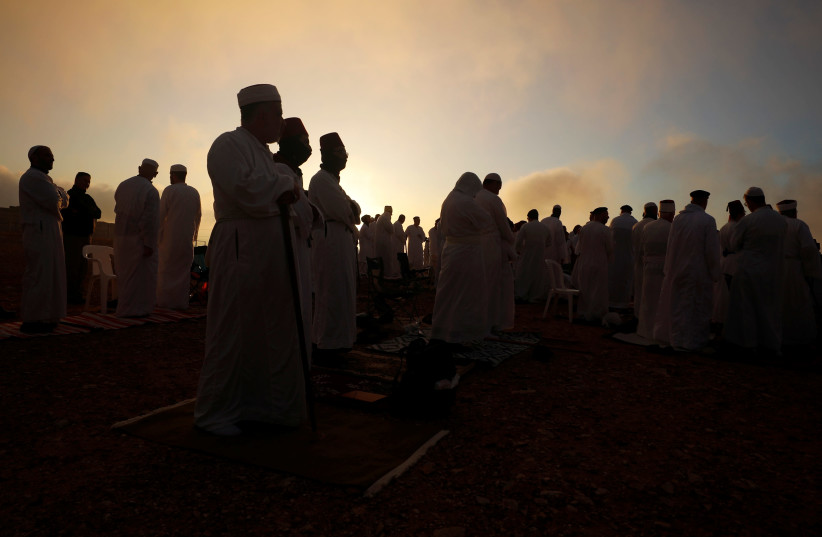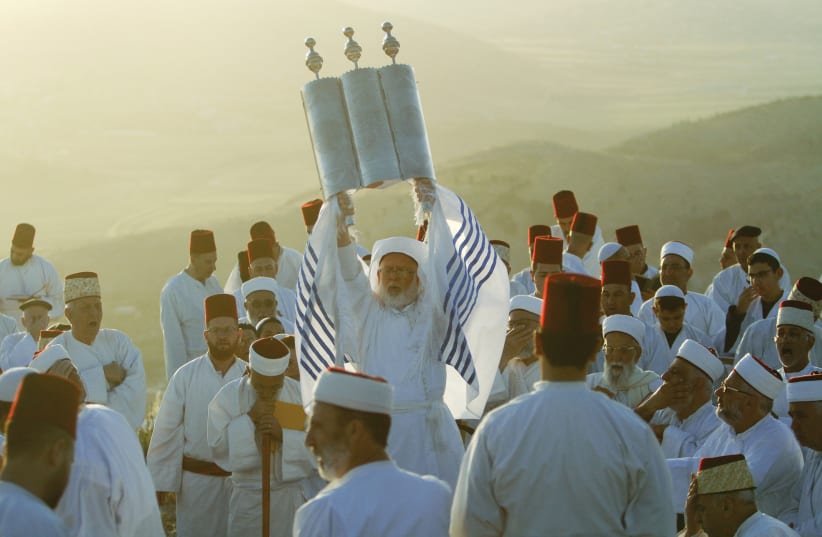The city of Jerusalem was most vital on the pilgrimage holidays of Passover, Shavuot and Sukkot. The Temple Mount teemed with life and sacrifice, as Jews made the trek from all over the known world to participate in the celebration. The Roman destruction of the Second Temple in 70 created a void that still pains our people to the present day.
But the liberation and reunification of the capital city in June 1967 have enabled a modern pilgrimage of Jews who walk the streets of Jerusalem and pray at the Kotel. Even without a Third Temple, we are living in a Jewish world that has, in part, been redeemed.
As we approach the Ninth of the Hebrew month of Av and commemorate the destruction of both temples in Jerusalem, there is a fascinating footnote to our history of another center of sacrificial cult that was destroyed – by Jews. That was the Samaritan Temple on Mount Gerizim.
The Samaritans considered Shechem, the site of their holy mountain, to be the holiest city, not Jerusalem. It was this issue that proved to be of deep division between Samaritan and Jew. The Samaritans believed they were God’s Chosen People, not the denizens further south in Eretz Yisrael with the capital in Jerusalem.
Who were the Samaritans? Their origin is shrouded in some mystery. Biblical historian Leonard J. Greenspoon states, “The Samaritans traced their lineage back to the same 12 tribes as the Judeans or Jews. While the Davidic monarchy and Jerusalem as the city of David were crucial for Judean self-understanding, the Samaritans could point to other ancient traditions associated with Shechem and other Samaritan sites with centralized and sacrificial worship of God. In effect, the supporters of the Samaritans claim to be the true Israel were drawing from the same traditional sources as the Judeans, but with vastly different interpretations and consequences.”


The Hebrew Bible roots the Jewish condemnation of the Samaritans as descendants of the Assyrian exile of the Northern Kingdom (“The Ten Lost Tribes”) in 721 BCE. The Assyrian military machine’s policy of neutralizing political enemies by mixing up captured populations was seen as the reason the northerners were idol worshipers who could not claim unity as descendants of the tribes of Jacob.
The building of a temple on Mount Gerizim was viewed by the Jews as a sin as egregious as the Northern Kingdom’s establishment of temples in Beth El and Dan during the period of the divided monarchy. When the Persians allowed Jews to return to Jerusalem to rebuild the Temple, Samaritan offers of helping to rebuild the city were swiftly rejected by the Jewish leadership.
The Samaritan version of the Torah
The Samaritan version of the Torah is fascinating and its existence seems to dispute their position as heretics to be dismissed, heterodox and irrelevant. Greenspoon continues: “Given the centuries of hostility between Jews and Samaritans, it is surprising to learn of the basic compatibility between the beliefs and the practices of the two feuding groups. The Samaritan Pentateuch and the form of the Torah accepted in Jerusalem had hundreds of minor differences between them. But apart from the former’s insistence that God has chosen Shechem as the place for his worship, there are few theologically crucial contradictions in these competing texts. Even after the destruction of its temple, the Samaritan priesthood retained much of it power and prestige. To this day, a small group sustains the distinctive core of Samaritan teaching: we, not they, are the true heirs of Moses.”
The Samaritans built their temple on Mount Gerizim – it had already obtained credence as a holy site in the Torah – at a time when relationships with the conquering Hellenists were good. But the temple would just stand for two centuries. John Hyrcanus, leader of the Hasmonean Jewish state (the result of Maccabee victories over the Seleucids), destroyed the temple on Mount Gerizim in 128 BCE.
Whether out of long-standing hatred and tension or simply for political reasons, the Hasmonean leader ransacked Shechem. He returned two decades later and completed the destruction of Shechem and of its sister-city Samaria. The destruction was thorough and carried out with great animus.
To describe a Jewish temple not located in Jerusalem is not to describe a Jewish temple. The Jewish yearning for return to Jerusalem was a hallmark of exile. But the uncomfortable reality is that the Samaritans differed with Jews on one major issue and possessed a Torah that was not radically different. At the time John Hyrcanus destroyed the temple on Mount Gerizim, the Samaritans were quite powerful and were a threat that had to be eliminated. But his destruction of Shechem was not subtle. His goal was expansion of the state, an area in which he excelled.
I cry no tears for the Samaritans. Mount Gerizim’s significance 2,300 years ago remains a footnote today. But for those Jews who only focus on the Ninth of Av and the Jewish people as victims, the destruction of the Samaritan Temple provides an alternative read on Jewish history. Jews are not saints. They are a people who have been killed in great numbers but also they have killed their enemies.
The tragedy is that the Samaritans could not be integrated into the Jewish people as a whole. But it was they who refused. As a student of history, I will not forget Shechem or the Samaritan Torah. To do so is to be dishonest and self-serving.
The writer is rabbi of Congregation Anshei Sholom in West Palm Beach, Florida.
